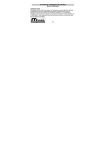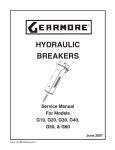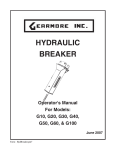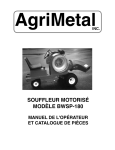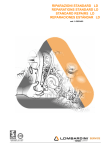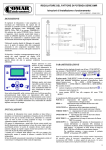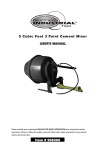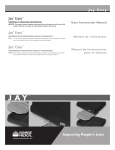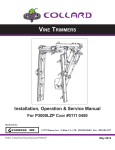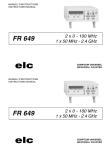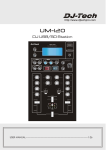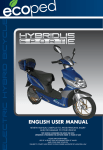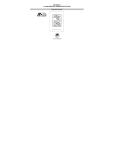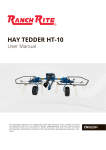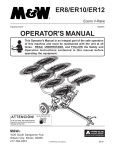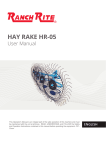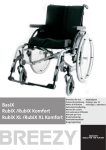Download front mount leaf and debris blower for john deere model
Transcript
1 INTRODUCTION Congratulations on your choice of an AgriMetal Front Mount Leaf and Debris Blowers for a John Deere Tractor to complement your operation. This equipment has been designed and manufactured to meet the needs of a discerning turf care industry. Safe, efficient and trouble free operation of your AgriMetal Leaf and Debris Blowers requires that you and anyone else who will be operating or maintaining the machine, read and understand the Safety, Operation, Maintenance and Trouble Shooting information contained within the Operator's Manual. This manual covers the Model BW 240 1400 Front Mount Leaf and Debris Blowers for a John Deere Model JD-2, JD-4 and JD-1400 Front Mount Tractor. Use the Table of Contents or Index as a guide to locate required information. Keep this manual handy for frequent reference and to pass on to new operators or owners. Call your AgriMetal Dealer or Distributor if you need assistance, information or additional copies of the manuals. OPERATOR ORIENTATION - The directions left, right, front and rear, as mentioned throughout this manual, are as seen from the tractor driver's seat and facing in the direction of travel. 1 2 SAFETY SAFETY ALERT SYMBOL This Safety Alert symbol means ATTENTION! BECOME ALERT! YOUR SAFETY IS INVOLVED! The Safety Alert symbol identifies important safety messages on the AgriMetal Front Mount Leaf and Debris Blowers and in the manual. When you see this symbol, be alert to the possibility of personal injury or death. Follow the instructions in the safety message. Why is SAFETY important to you? 3 Big Reasons SIGNAL WORDS: Note the use of the signal words DANGER, WARNING and CAUTION with the safety messages. The appropriate signal word for each message has been selected using the following guide-lines: Accidents Disable and Kill Accidents Cost Accidents Can Be Avoided DANGER - Indicates an imminently hazardous situation that, if not avoided, will result in death or serious injury. This signal word is to be limited to the most extreme situations typically for machine components which, for functional purposes, cannot be guarded. WARNING - Indicates a potentially hazardSI NO LEE INGLES, PIDA AYUDA A AIGUIEN QUE SI LO LEA PARA QUE LE TRADUZCA LAS MIDIDAS DE SEGURIDAD. ous situation that, if not avoided, could result in death or serious injury, and includes hazards that are exposed when guards are removed. It may also be used to alert against unsafe practices. CAUTION - Indicates a potentially hazardous situation that, if not avoided, may result in minor or moderate injury. It may also be used to alert against unsafe practices. If you have any questions not answered in this manual or require additional copies or the manual is damaged, please contact your dealer or AgriMetal Inc., 1006 Rue Principale, Wickham, Quebec, Canada, J0C 1S0. Phone (819) 398-6883 or fax (819) 398-5311. 2 SAFETY YOU are responsible for the SAFE operation and maintenance of your AgriMetal Front Mount Leaf and Debris Blowers for John Deere Front Mount Tractors. YOU must ensure that you and anyone else who is going to operate, maintain or work around the Leaf and Debris Blowers be familiar with the operating and maintenance procedures and related SAFETY information contained in this manual. This manual will take you step-by-step through your working day and alerts you to all good safety practices that should be adhered to while operating the Leaf and Debris Blowers. Remember, YOU are the key to safety. Good safety practices not only protect you but also the people around you. Make these practices a working part of your safety program. Be certain that EVERYONE operating this equipment is familiar with the recommended operating and maintenance procedures and follows all the safety precautions. Most accidents can be prevented. Do not risk injury or death by ignoring good safety practices. • Leaf and Debris Blowers owners must give operating instructions to operators or employees before allowing them to operate the machine, and at least annually thereafter per OSHA (Occupational Safety and Health Administration) regulation 1928.57. • The most important safety device on this equipment is a SAFE operator. It is the operator’s responsibility to read and understand ALL Safety and Operating instructions in the manual and to follow these. Most accidents can be avoided. • A person who has not read and understood all operating and safety instructions is not qualified to operate the machine. An untrained operator exposes himself and bystanders to possible serious injury or death. • Do not modify the equipment in any way. Unauthorized modification may impair the function and/or safety and could affect the life of the equipment. • Think SAFETY! Work SAFELY! 2.1 GENERAL SAFETY 1. Read and understand the Operator’s Manual and all safety signs before operating, maintaining, adjusting or unplugging the Leaf and Debris Blowers. 2. Have a first-aid kit available for use should the need arise and know how to use it. 3. Have a fire extinguisher available for use should the need arise and know how to use it. 4. Do not allow riders. 5. Wear appropriate protective gear. This list includes but is not limited to: - A hard hat - Protective shoes with slip resistant soles - Protective glasses or goggles - Heavy gloves - Hearing protection - Respirator or filter mask 6. Install and secure all guards before starting. 7. Wear suitable ear protection for prolonged exposure to excessive noise. 8. Place all controls in neutral, stop engine, set park brake, remove ignition key and wait for all moving parts to stop before servicing, adjusting, repairing or unplugging. 9. Clear the area of people, especially small children, before starting the unit. 10. Review safety related items annually with all personnel who will operating or maintaining the Leaf and Debris Blowers. 3 2.2 EQUIPMENT SAFETY GUIDELINES 1. Safety of the operator and bystanders is one of the main concerns in designing and developing a machine. However, every year many accidents occur which could have been avoided by a few seconds of thought and a more careful approach to handling equipment. You, the operator, can avoid many accidents by observing the following precautions in this section. To avoid personal injury or death, study the following precautions and insist those working with you, or for you, follow them. 2. In order to provide a better view, certain photographs or illustrations in this manual may show an assembly with a safety shield removed. However, equipment should never be operated in this condition. Keep all shields in place. If shield removal becomes necessary for repairs, replace the shield prior to use. 3. Replace any safety sign or instruction sign that is not readable or is missing. Location of such safety signs is indicated in this manual. 4. Never use alcoholic beverages or drugs which can hinder alertness or coordination while operating this equipment. Consult your doctor about operating this machine while taking prescription medications. 5. Under no circumstances should young children be allowed to work with this equipment. Do not allow persons to operate or assemble this unit until they have read this manual and have developed a thorough understanding of the safety precautions and of how it works. Review the safety instructions with all users annually. 6. This equipment is dangerous to children and persons unfamiliar with its operation. The operator should be a responsible, properly trained and physically able person familiar with machinery and trained in this equipment's operations. If the elderly are assisting with work, their physical limitations need to be recognized and accommodated. 7. Use a tractor equipped with a Roll Over Protective Structure (ROPS). 4 8. Never exceed the limits of a piece of machinery. If its ability to do a job, or to do so safely, is in question - DON'T TRY IT. 9. Do not modify the equipment in any way. Unauthorized modification result in serious injury or death and may impair the function and life of the equipment. 10. In addition to the design and configuration of this implement, including Safety Signs and Safety Equipment, hazard control and accident prevention are dependent upon the awareness, concern, prudence, and proper training of personnel involved in the operation, transport, maintenance, and storage of the machine. Refer also to Safety Messages and operation instruction in each of the appropriate sections of the power unit, engine and machine Manuals. Pay close attention to the Safety Signs affixed to the power unit and the machine. 2.3 SAFETY TRAINING 2.4 SAFETY SIGNS 1. Safety is a primary concern in the design and manufacture of our products. Unfortunately, our efforts to provide safe equipment can be wiped out by a single careless act of an operator or bystander. 1. Keep safety signs clean and legible at all times. 2. In addition to the design and configuration of equipment, hazard control and accident prevention are dependent upon the awareness, concern, prudence and proper training of personnel involved in the operation, transport, maintenance and storage of this equipment. 3. Replaced parts that displayed a safety sign should also display the current sign. 3. It has been said, "The best safety feature is an informed, careful operator." We ask you to be that kind of an operator. It is the operator's responsibility to read and understand ALL Safety and Operating instructions in the manual and to follow these. Accidents can be avoided. How to Install Safety Signs: 4. Working with unfamiliar equipment can lead to careless injuries. Read this manual, and the manual for your power unit, before assembly or operating, to acquaint yourself with the machines. If this machine is used by any person other than yourself, or is loaned or rented, it is the machine owner's responsibility to make certain that the operator, prior to operating: a. Reads and understands the operator's manuals. b. Is instructed in safe and proper use. 2. Replace safety signs that are missing or have become illegible. 4. Safety signs are available from your authorized Distributor or Dealer Parts Department or the factory. • Be sure that the installation area is clean and dry. • Be sure temperature is above 50°F (10°C). • Determine exact position before you remove the backing paper. • Remove the smallest portion of the split backing paper. • Align the sign over the specified area and carefully press the small portion with the exposed sticky backing in place. • Slowly peel back the remaining paper and carefully smooth the remaining portion of the sign in place. • Small air pockets can be pierced with a pin and smoothed out using the piece of sign backing paper. 5. Know your controls and how to stop power unit, engine, and machine quickly in an emergency. Read this manual and the one provided with your power unit. 6. Train all new personnel and review instructions frequently with existing workers. Be certain only a properly trained and physically able person will operate the machinery. A person who has not read and understood all operating and safety instructions is not qualified to operate the machine. An untrained operator exposes himself and bystanders to possible serious injury or death. If the elderly are assisting with work, their physical limitations need to be recognized and accommodated. 5 2.5 PREPARATION 1. Never operate the power unit and machine until you have read and completely understand this manual, the Power Unit Operator's Manual, and each of the Safety Messages found on the safety signs on the power unit and machine. 2. Personal protection equipment including hard hat, safety glasses, safety shoes, and gloves are recommended during assembly, installation, operation, adjustment, maintaining, repairing, removal, or moving the implement. Do not allow long hair, loose fitting clothing or jewellery to be around equipment. 3. PROLONGED EXPOSURE TO LOUD NOISE MAY CAUSE PERMANENT HEARING LOSS! Power Units with or without equipment attached can often be noisy enough to cause permanent, partial hearing loss. We recommend that you wear hearing protection on a full-time basis if the noise in the Operator's position exceeds 80db. Noise over 85db on a long-term basis can cause severe hearing loss. Noise over 90db adjacent to the Operator over a longterm basis may cause permanent, total hearing loss. NOTE: Hearing loss from loud noise (from tractors, chain saws, radios, and other such sources close to the ear) is cumulative over a lifetime without hope of natural recovery. 4. Operate the machine only with a tractor equipped with an approved Roll-OverProtective Structure (ROPS). Always wear your seat belt. Serious injury or even death could result from falling off the tractor ---particularly during a turnover when the operator could be pinned under the ROPS or the tractor. 6 5. Clear working area of stones, branches or hidden obstacles that might be hooked or snagged, causing injury or damage. 6. Operate only in daylight or good artificial light. 7. Be sure machine is properly mounted, adjusted and in good operating condition. 8. Ensure that all safety shielding and safety signs are properly installed and in good condition. 2.6 STORAGE SAFETY 1. Store the unit in an area away from human activity. 2. Do not permit children to play on or around the stored machine. 3. Store the unit in a dry, level area. Support the frame with planks if required. 4. Cover with a weather-proof tarpaulin and tie down securely. 2.7 OPERATING SAFETY 1. Please remember it is important that you read and heed the safety signs on the Blower. Clean or replace all safety signs if they cannot be clearly read and understood. They are there for your safety, as well as the safety of others. The safe use of this machine is strictly up to you, the operator. 2. All things with moving parts are potentially hazardous. There is no substitute for a cautious, safe-minded operator who recognizes potential hazards and follows reasonable safety practices. The manufacturer has designed this Leaf and Debris Blowers to be used with all its safety equipment properly attached, to minimize the chance of accidents. Study this manual to make sure you have all safety equipment attached. 3. If a safety shield or guard is removed for any reason, it must be replaced before the machine is again operated. 4. When the use of hand tools is required to perform any part of assembly, installation, adjustment, maintaining, repairing, removal, or moving, be sure the tools used are designed and recommended by the tool manufacturer for that specific task. 5. Personal protection equipment including hearing protection, hard hat, safety glasses, safety shoes, and gloves are recommended during assembly, installation, operation, adjustment, maintaining, repairing, removal, or moving. Do not allow long hair, loose fitting clothing, or jewellery to be around moving parts. 6. Always use two people to handle heavy, unwieldy components during assembly, installation, removal or moving. 7. Never place any part of your body where it would be in danger if movement should occur during assembly, installation, operation, maintaining, repairing, removal or moving. 8. Never place yourself between the power unit and machine while machine is in operation. 10. A heavy load can cause instability of the power unit. Use extreme care during travel. Slow down on turns and watch out for bumps. The power unit may need rear counterweights to counterbalance the weight of the machine. 11. Never use alcoholic beverages or drugs which can hinder alertness or coordination while operating this equipment. Consult your doctor about operating this machine while taking prescription medications. 12. Do not allow riders on the machine or power unit at any time. There is no safe place for any riders. 13. Before you operate the machine, check over all pins, bolts, and connections to be sure all are securely in place. Replace any damaged or worn parts immediately. 14. Keep all hydraulic lines, fittings and couplers tight and free of leaks before using. 15. Do not allow anyone who is not familiar with the safety rules and operation instructions to use this machine. 16. Never allow children to operate or be around this machine. 17. Do not reach into blower openings when the engine is running. Keep others away also. 18. Clear the work area of objects which might be picked up and snagged or entangled in the machine. 19. Keep hands, feet, hair, jewellery, and clothing away from all moving and/or rotating parts. 20. Do not direct the air stream toward people, animals or buildings to prevent injury or damage. 21. Do not place hands, feet or other body parts into air stream. 22. Always wear eye protection when working next to Blower. 9. Place all controls in neutral, stop engine, set park brake, remove ignition key and wait for all moving parts to stop before servicing, adjusting, repairing or unplugging. 7 2.8 TRANSPORT SAFETY 1. Comply with state and local laws governing highway safety and movement of machinery on public roads. 2.9 MAINTENANCE SAFETY 1. Good maintenance is your responsibility. Poor maintenance is an invitation to trouble. 2. Follow good shop practices. 2. The use of flashing amber lights is acceptable in most localities. However, some localities prohibit their use. Local laws should be checked for all highway lighting and marking requirements. 3. At all times when driving the power unit and equipment on the road or highway under 20 mph (32 kph), use flashing amber warning lights and a slow moving vehicle (SMV) identification emblem. Do not exceed 20 mph (32 kph). Reduce speed on rough roads and surfaces. 4. Plan your route to avoid heavy traffic. 5. Use mounting pins with provisions for a retainer. Install the retainer. 6. Do not drink and drive. 7. Be a safe and courteous driver. Always yield to oncoming traffic in all situations, including narrow bridges, intersections, etc. Watch for traffic when operating near or crossing roadways. 8. Turn into curves or go up or down hills only at a low speed and at a gradual steering angle. Make certain that at least 20% of the power unit's weight is on the front wheels to maintain safe steerage. Slow down on rough or uneven surfaces. 9. Never allow riders on either tractor or machine. 10. Be sure lights and reflectors on the tractor are clean and in good working order before transporting. - Keep service area clean and dry. - Be sure electrical outlets and tools are properly grounded. - Use adequate light for the job at hand. 3. Make sure there is plenty of ventilation. Never operate an engine in a closed building. The exhaust fumes may cause asphyxiation. 4. Before working on this machine, shut off the engine, set the brakes, and remove the ignition keys. 5. Never work under equipment unless it is blocked securely. 6. Always use personal protection devices such as eye, hand and hearing protectors, when performing any service or maintenance work. 7. Where replacement parts are necessary for periodic maintenance and servicing, genuine factory replacement parts must be used to restore your equipment to original specifications. The manufacturer will not be responsible for injuries or damages caused by use of unapproved parts and/or accessories. 8. A fire extinguisher and first aid kit should be kept readily accessible while performing maintenance on this equipment. 9. Periodically tighten all bolts, nuts and screws and check that all cotter pins are properly installed to ensure unit is in a safe condition. 10. When completing a maintenance or service function, make sure all safety shields and devices are installed before placing unit in service. 8 2.10 SIGN-OFF FORM AgriMetal follows the general Safety Standards specified by the American Society of Agricultural Engineers (ASAE) and the Occupational Safety and Health Administration (OSHA). Anyone who will be operating and/ or maintaining the Front Mount Leaf and Debris Blowers must read and clearly understand ALL Safety, Operating and Maintenance information presented in this manual. Do not operate or allow anyone else to operate this equipment until such information has been reviewed. Annually review this information before the season start-up. Make these periodic reviews of SAFETY and OPERATION a standard practice for all of your equipment. We feel that an untrained operator is unqualified to operate this machine. A sign-off sheet is provided for your record keeping to show that all personnel who will be working with the equipment have read and understand the information in the Operator’s Manual and have been instructed in the operation of the equipment. SIGN-OFF FORM DATE EMPLOYEES SIGNATURE EMPLOYERS SIGNATURE 9 3 SAFETY SIGN LOCATIONS The types of safety signs and locations on the equipment are shown in the illustrations that follow. Good safety requires that you familiarize yourself with the various safety signs, the type of warning and the area, or particular function related to that area, that requires your SAFETY AWARENESS. • Think SAFETY! Work SAFELY! A E F D C A CAUTION 1. 2. Read Operator's Manual before starting. Keep guards and shields in place and access doors closed. 3. Keep hands, feet, hair and clothing away from moving parts. 4. Stop engine, place all controls in neutral, set park brake, remove ignition key and wait for all moving parts to stop before servicing, adjusting, repairing or unplugging the machine. 5. Do not climb on the machine or place hands in any opening when the engine is running. 6. Keep people and pets a safe distance from the machine. 7. Do not smoke when refuelling. 8. Block up machine securely before working under it. 9. Keep all electrical wires and connections dry and in good repair. 10. Do not direct discharge duct or hose toward people, animals or property to prevent being hit by fast moving objects. Always wear appropriate safety gear during operation. 11. Review safety instructions annually. ATTENTION 1. 2. 3. 4. 5. 6. Lire attentivent le manuel d'opération avant la mise en marche. Garder tous les écrans protecteurs en place. Garder les mains, pieds, cheveux et vétements éloignés des éléments mobiles. Arréter le moteur, placer tous les contròles à la position "neutre", enlever la clé du contact et attendre que toutes les pieces soient au point mort avant de faire tout ajustement, réparation ou de débloquer la machine. Ne pas grimper sur la machine et ne jamais se placer les mains dans toute ouverture lorsque celle-ci est en marche. Garder les gens et les animaux à une distance sécuritaire de la machine. 7. 8. Ne jamais fümer lors du plein d'essence. Immobiliser la machine de façon sécuritaire avant de travailler sous celle-ci. 9. Garder toute connection et fil électrique au sec et en bonne condition. 10. Afin d'éviter tout risque d'accident grave, ne jamais souffler en direction des gens, animaux ou vers les propriétées. Le port des équipements de sécurité est obligatoire lorsque vous opéré la machine. 11. Reviser annuellement le manual d'opération. NC13-33-0108 REMEMBER - If safety signs have been damaged, removed, become illegible or parts replaced without safety signs, new signs must be applied. New safety signs are available from your authorized dealer. 10 The types of safety signs and locations on the equipment are shown in the illustrations that follow. Good safety requires that you familiarize yourself with the various safety signs, the type of warning and the area, or particular function related to that area, that requires your SAFETY AWARENESS. • Think SAFETY! Work SAFELY! B DANGER BLOWER BLADE HAZARD PROPULSEUR EN ROTATION RISQUE To prevent serious injury or DE BLESSURE GRAVE death from blower blade hazard: Á défaut de suivre ces instructions, cela pourrait entraîner de sérieuses blessures ou 1. Do not open blower access même la mort. doors when the engine is running. 1. Ne jamais ouvrir les portes d'accès du 2. Do not place hands or feet into souffleur lorsque le moteur est en marche. blower openings when engine 2. Arrêter le moteur, placer tous les contrôles à la running. Keep others away. position "neutre", enlever la clé du contact et 3. Stop engine, place all controls attendre que toutes les pieces soient au point in neutral, set park brake, mort avant de faire tout ajustement, réparation remove ignition key and wait ou de débloquer la machine. for all moving parts to stop 3. Arrêter le moteur, placer tous les contrôles à la before servicing, adjusting, position "neutre", enlever la clé du contact et repairing or unplugging maattendre que toutes les pieces soient au point chine. mort avant de faire tout ajustement, réparation 4. Do not operate with access ou de débloquer la machine. doors removed. 4. Ne jamais opérer sans portes d'accès. NC13-33-0112 C WARNING ROTATING DRIVELINE HAZARD KEEP AWAY To prevent serious injury or death from rotating driveline: 1. 2. 3. 4. 5. Keep all guards in place when operating. Operate at 540 RPM. Keep hands, feet, hair and clothing away from moving parts. Keep U joint angles equal and small as possible. Do not exceed driveline manufacturer's recommended operating length. PRISE DE FORCE EN ROTATION RESTER ÉLOIGNÉ Á défaut de suivre ces instructions, cela pourrait entraîner de sérieuses blessures ou même la mort. 1. 2. 3. 4. 5. Garder tous les écrans protecteurs en place. Operer à 540 Tours/minute. Garder les mains, pieds, cheveux et vêtements éloignés des éléments mobiles. Garder les angles de joint en U égales et le plus petit possible. Ne pas excèder la longueur d'opération de la prise de force recommandé par le manufacturier. 01-60-0125 REMEMBER - If safety signs have been damaged, removed, become illegible or parts replaced without safety signs, new signs must be applied. New safety signs are available from your authorized dealer. 11 The types of safety signs and locations on the equipment are shown in the illustrations that follow. Good safety requires that you familiarize yourself with the various safety signs, the type of warning and the area, or particular function related to that area, that requires your SAFETY AWARENESS. • Think SAFETY! Work SAFELY! B C B D D D D DANGER THROWN OBJECT HAZARD To prevent serious injury or death from a thrown object: 1. Stop engine, place all controls in neutral, set park brake, remove ignition key and wait for all moving parts to stop before servicing, adjusting, repairing or unplugging machine. 2. Do not direct discharge duct toward people, animals or property. Always wear appropriate safety gear. Keep hands and feet out of discharge openings. 3. Keep others away. RISQUE D'OBJETS PROJETÉS Á défaut de suivre ces instructions, cela pourrait entraîner de sérieuses blessures ou même la mort. 1. Arrêter le moteur, placer tous les contrôles à la position "neutre", enlever la clé du contact et attendre que toutes les pieces soient au point mort avant de faire tout ajustement, réparation ou de débloquer la machine. 2. Afin d'éviter tout risque d'accident grave, ne jamais souffler en direction des gens, des animaux ou vers les propriétées. Le port des équipements de sécurité est obligatoire lorsque vous opérez la machine. 3. Garder les gens éloignés de la machine. NC13-33-0110 REMEMBER - If safety signs have been damaged, removed, become illegible or parts replaced without safety signs, new signs must be applied. New safety signs are available from your authorized dealer. 12 The types of safety signs and locations on the equipment are shown in the illustrations that follow. Good safety requires that you familiarize yourself with the various safety signs, the type of warning and the area, or particular function related to that area, that requires your SAFETY AWARENESS. • Think SAFETY! Work SAFELY! E WARNING MISSING SHIELD HAZARD D A To prevent serious injury or death from exposed hazard: 1. Install and secure shields before operating. 2. Keep hands, feet, hair and clothing away from moving parts. E AVERTISSEMENT GARDE ABSENT Á défaut de suivre ces instructions, cela pourrait entraîner de sérieuses blessures ou même la mort. C 1. Installer les gardes de façon sécuritaire avant la mise en marche de la machine. 2. Garder les mains, pieds, cheveux et vêtements éloignés des éléments mobiles. 01-60-0070 F WARNING AVERTISSEMENT ROTATING PART HAZARD KEEP AWAY To prevent serious injury or death from rotating parts: 1. Place all controls in neutral or off, stop engine or motor, set park brake, remove ignition key or disable power source and wait for all moving parts to stop before servicing, adjusting, repairing or unplugging. 2. Install and secure all guards before operating. 3. Do not operate with rotating parts exposed. PIÈCES EN MOUVEMENT RESTER ÉLOIGNÉ Á défaut de suivre ces instructions, cela pourrait entraîner de sérieuses blessures ou même la mort. 1. 2. 3. Arrêter le moteur, placer tous les contrôles à la position "neutre" enlever la clé du contact et attendre que toutes les pieces soient au point mort avant de faire tout ajustement, réparation ou de débloquer la machine. Installer tous les écrans protecteurs avant de mettre la machine en fonction. Ne jamais opérer la machine sans écran protecteur. 01-60-0115 REMEMBER - If safety signs have been damaged, removed, become illegible or parts replaced without safety signs, new signs must be applied. New safety signs are available from your authorized dealer. 13 4 ASSEMBLING 4.1 MACHINE ASSEMBLY The machine is shipped from the factory in a partially disassembled configuration and attached to a pallet that provides for easy moving and handling. Always use tools, equipment and forklifts of appropriate size and capacity for the job. Always use 2 men when lifting, moving and assembling the machine. When the machine is shipped, follow this procedure when preparing for the customer: Wrapped 1. Clear the area of bystanders especially small children before starting. 2. Remove the pallet tie-downs. 3. Use a forklift to lift the pallet/machine from the truck. Carry the load close to the ground as it is moved to the assembly area and positioned. 4. Remove plastic wrap. 5. Remove steel strapping. Unwrapped Fig. 1 SHIPPING CONFIGURATION 6. Remove deflector and control handle and layout. Fig. 2 LAYOUT 14 7. Remove the deflector position cable from the pulley. Fig. 3 CABLE 8. Install rear guide rod through duct assembly. Be sure to position the washer above the clip and to install clip retainer. Fig. 4 REAR ROD 9. Install front guide rod through the duct assembly. Be sure to position the washer above the clip and to install clip retainer. Fig. 5 FRONT GUIDE ROD 15 10. Mount the cable anchor bracket to the front frame. Fig. 6 CABLE ANCHOR BRACKET 11. Connect cable to the top of the deflector. Fig. 7 CABLE/DEFLECTOR CONNECTED 12. Pull cable and clip clamp behind fork in bracket. 16 Fig. 8 CLAMP/FORK 13. Remove the tape and key from the input shaft. Be sure to keep the key available when the driveline is installed. Fig. 9 INPUT SHAFT 14. Remove the blower from the pallet. Fig. 10 BLOWER 17 15. Place the key in its keyway and slide the yoke over the input shaft. Fig. 11 YOKE 16. Install the clamping bolt and tighten to its specified torque. Fig. 12 CLAMPING BOLT 18 5 OPERATION OPERATING SAFETY • Always wear eye protection when working next to Blower. • Never allow children to operate or be around this machine. • If a safety shield or guard is removed for any reason, it must be replaced before the machine is again operated. • Do not reach into blower openings when the engine is running. Clear the work area of objects which might be picked up and snagged or entangled in the machine. • Always use two people to handle heavy, unwieldy components during assembly, installation, removal or moving. • Clear the work area of objects which might be picked up and snagged or entangled in the machine. • Keep all hydraulic lines, fittings and couplers tight and free of leaks before using. • Keep hands, feet, hair, jewellery, and clothing away from all moving and/or rotating parts. • Do not direct the air stream toward people, animals or buildings to prevent injury or damage. • Do not place hands, feet or other body parts into air stream. • Place all controls in neutral, stop engine, set park brake, remove ignition key and wait for all moving parts to stop before servicing, adjusting, repairing or unplugging. • Do not allow riders on the machine or power unit at any time. There is no safe place for any riders. • Do not allow anyone who is not familiar with the safety rules and operation instructions to use this machine. 5.1 TO THE NEW OPERATOR OR OWNER AgriMetal Front Mount Leaf and Debris Blowers are designed to quickly and efficiently, blow away leaves, cuttings and other debris. The material is conveyed on a stream of high velocity air to remove it from the area of concern. When the material is removed, it gives a neat, professional look to the working area. Follow all safety instructions exactly. Safety is everyone's business. By following recommended procedures, a safe working environment is provided for the operator, bystanders and the area around the worksite. Untrained operators are not qualified to operate the machine. In addition to the design and configuration of equipment, hazard control and accident prevention are dependent upon the awareness, concern, prudence and proper training of personnel involved in the operation, transport, maintenance and storage of equipment. It is the responsibility of the owner or operator to read this manual and to train all other operators before they start working with the machine. Many features incorporated into this machine are the result of suggestions made by customers like you. Read this manual carefully to learn how to operate the machine safely and how to set it to provide maximum field efficiency. By following the operating instructions in conjunction with a good maintenance program, your Front Mount Leaf and Debris Blowers will provide many years of troublefree service. 19 5.2 MACHINE COMPONENTS The AgriMetal Front Mount Leaf and Debris Blowers is a large blower mounted on a Front Mount John Deere Tractor for moving debris on a stream of air. The air stream can be directed to the right or forward depending on the discharge duct position. Power to the machine is provided by a PTO driveline through a V belt to the blower. A roller on the back of the frame and a castor wheel in front keeps the machine level with the ground. A WARNING F C Machine is shown with guard removed for illustrative purposes only. Do not operate machine with guard removed. E D B C F B A B C D E F Discharge Duct Attaching Hitch Blower Roller V Belt Drive Duct Cable A Fig. 13 PRINCIPLE COMPONENTS 20 5.3 BREAK-IN Although there are no operational restrictions on the Blower when it is used for the first time, it is recommended that the following mechanical items be checked: A. After operating for 1 hour: 1. Check alignment of pulleys. Align as required. 2. Check belt tension and alignment. Adjust as required. 5.4 PRE-OPERATION CHECKLIST Efficient and safe operation of the AgriMetal Front Mount Leaf and Debris Blowers requires that each operator reads and understands the operating procedures and all related safety precautions outlined in this section. A pre-operation checklist is provided for the operator. It is important for both personal safety and for maintaining the machine in good mechanical condition that this checklist be followed. Before operating the Blower and each time thereafter, the following areas should be checked off: 3. Torque all fasteners and hardware. 4. Check condition of blower bearings. B. After operating for 10 hours: 1. Repeat steps 1 through 4 listed above. (Section A). 2. Go to the normal servicing and maintenance schedule as defined in the Maintenance Section. 1. Lubricate the machine per the schedule outline in the Maintenance Section. 2. Use only with a John Deere Front Mount mower tractor. 3. Be sure that the machine is properly attached to the tractor with retainers in each mounting pin. 4. Be sure the PTO driveline is securely attached on both ends and can telescope easily. 5. Check the tension and alignment of all belts and pulleys. Adjust tension and align as required. 6. Check that all bearings turn freely. Replace any that are rough or seized. 7. Make sure that all guards and shields are in place, secured and functioning as designed. 8. Clean the openings over the blower intake slots. 21 5.5 CONTROLS Before starting to work, all operators should familiarize themselves with the location and function of the controls. 1. Duct Position Cable: The duct assembly position is controlled by a cable routed through a pulley. Pull on the cable and place the second clamp behind a forked bracket on the front of the frame. Place the first clamp behind the forked bracket to lower the duct. Raised Lowered Fig. 14 DUCT POSITION CABLE 22 5.6 MOUNTING AND UNHOOKING TRACTOR When attaching Blower to a tractor, follow this procedure: 1. Clear the area of bystanders especially small children before starting. 2. Make sure there is enough room and clearance from obstacles to safely drive up to the Blower. 3. Drive slowly up and align the lower link arms to the mounting brackets on the Blower. 4. Align the left lower link arm with the left Blower arm. NOTE It may be necessary to add weight to the lift arms to bring them to the required height. Fig. 15 ALIGNING 5. Drive up to the blower until the pin holes are aligned. 6. Install the left pin through the arm and install the retainer. 7. Install the right mounting pin and retainer. Fig. 16 MOUNTING PINS 23 8. Attach the PTO Driveline: a. Check that the driveline telescopes easily. b. Open the floor board on the tractor. c. Attach the driveline to the tractor by retracting the locking collar and sliding the yoke over the shaft. Push on the yoke until the lock pin clicks into position. Pull on the yoke to be sure it is locked in position. 9. Slowly raise the machine through its working range to make sure there is no interference with the frame. 10. Use the castor wheel shaft spacers to set the frame height. Fig. 17 FLOOR BOARD/DRIVELINE To adjust, follow this procedure: a. Raise the Blower high enough off the ground to allow the castor shaft to slide out of its mount. b. Place blocks or a safety stand under the frame to prevent it from falling. c. Remove the retainer and pin at the top of the castor shaft. d. Slide the castor shaft out of its mount. e. Slide 1 of the spacers that were on top of the frame over the shaft . f. Assemble the shaft back into the frame. 3 On Top g. Install the 2 remaining spacers over the shaft. h. Install the anchor pin and retainer. i. Lower the machine to the ground and check to see that it is level. j. The blower should always run level with the ground with the blower housing above the ground. 11. To unhook from the tractor, reverse the above procedure. Always park the machine in a dry, level area. If it is necessary to remove part of the PTO shaft to prevent vandalism, cover the remaining end for protection against dirt and the elements. 24 2 On Top Fig. 18 WHEEL SHAFT SPACERS 5.7 FIELD OPERATION OPERATING SAFETY • Always wear eye protection when working next to Blower. • Never allow children to operate or be around this machine. • If a safety shield or guard is removed for any reason, it must be replaced before the machine is again operated. • Do not reach into blower openings when the engine is running. Clear the work area of objects which might be picked up and snagged or entangled in the machine. • Always use two people to handle heavy, unwieldy components during assembly, installation, removal or moving. • Clear the work area of objects which might be picked up and snagged or entangled in the machine. • Keep all hydraulic lines, fittings and couplers tight and free of leaks before using. • Keep hands, feet, hair, jewellery, and clothing away from all moving and/or rotating parts. • Do not direct the air stream toward people, animals or buildings to prevent injury or damage. • Do not place hands, feet or other body parts into air stream. • Place all controls in neutral, stop engine, set park brake, remove ignition key and wait for all moving parts to stop before servicing, adjusting, repairing or unplugging. • Do not allow riders on the machine or power unit at any time. There is no safe place for any riders. • Do not allow anyone who is not familiar with the safety rules and operation instructions to use this machine. Blowers can be used for a wide variety of applications to move or windrow leaves and debris as far as the air stream will carry it. Removing grass clippings or other debris from paved surfaces or greens is limited only by how far it is to be moved. By directing the air stream over a wet area, it can be dried quickly. When operating the machine, follow this procedure: 1. Clear the area of bystanders, especially small children. 6. Place all controls in neutral before starting the tractor. 2. Review and follow the Pre-Operation Checklist (see Section 5.4). 7. The hitch control on the tractor should always be set in the float position to allow the machine to follow the ground contour. Skid plates on the bottom of the housing protect the machine. 3. Attach the machine to the John Deere Tractor (see Section 5.6). Be sure the frame is level. 4. Transport to the working area (refer to Section 5.8). 5. Start and operate the Blower only while seated on the tractor seat. 8. The machine should always ride on its wheel and roller to follow the ground contour. Spacers are provided on the gauge wheel shaft to adjust the wheel height. 25 9. Starting Blower: a. Engage the tractor PTO control only at low idle engine speed. b. Feather the control when engaging the PTO clutch to minimize the dynamic loads on the belts and drivetrain. 10. Stopping Blower: a. Gradually slow the tractor RPM down to low idle using the throttle. b. Slowly disengage PTO clutch and allow the propeller speed to slow. Gradually place the PTO control into its off lock position. IMPORTANT Newer tractors are designed with a PTO brake that will stop the shaft rotation within 1 revolution. Abrupt application of this brake can overload the rotor, belts and driveline. Always stop propeller gradually. Raised 11. Operating RPM: a. Run the blower at a fast enough speed to get the job done. Change ground speed by shifting gears on the tractor. Running at a higher speed uses extra fuel for no good reason. b. Moving light material, such as dry leaves, requires much less wind than wet or heavier material. c. Do not overspeed the blower. Higher speeds can lead to machine vibration or affect the mechanical integrity of the propeller. Down 12. Travel Speed: Fig. 19 DUCT POSITION Set the travel appropriate for the job being done. Travel faster if all the debris is being blown away. Slow down if some debris is not being removed. b. Air is directed to the right when the duct is 13. Air Flow Direction: raised. a. Air is directed forward when the duct is down. 26 c. Always secure the clamps on the cord in the forked bracket. 14. Protective Gear: Anyone working around the machine should always wear a face shield to prevent dirt, grit or trash from striking the face or eyes. 15. Clean the intake slots as required to insure ample flow of air to the fan. Left-Less Air 16. Always try to blow with the wind. Blowing against the wind can result in lifting the material into the wind and having it blown over a wider area. 17. Outlet Duct: A restrictor is designed into the outlet duct of the blower to control the amount of air being discharged. Loosen the anchor nut and slide the bolt to the left for less air and right for more. Tighten fastener to its specified torque. 18. Never direct air stream toward people, animals or buildings. Right-More Air Fig. 20 OUTLET DUCT RESTRICTOR DANGER RISQUE D'OBJETS PROJETÉS THROWN OBJECT HAZARD To prevent serious injury or death from a thrown object: Á défaut de suivre ces instructions, cela pourrait entraîner de sérieuses blessures ou même la mort. 1. 1. 2. 3. Stop engine, place all controls in neutral, set park brake, remove ignition key and wait for all moving parts to stop before servicing, adjusting, repairing or unplugging machine. Do not direct discharge duct toward people, animals or property. Always wear appropriate safety gear. Keep hands and feet out of discharge openings. Keep others away. 2. 3. Arrêter le moteur, placer tous les contrôles à la position "neutre", enlever la clé du contact et attendre que toutes les pieces soient au point mort avant de faire tout ajustement, réparation ou de débloquer la machine. Afin d'éviter tout risque d'accident grave, ne jamais souffler en direction des gens, des animaux ou vers les propriétées. Le port des équipements de sécurité est obligatoire lorsque vous opérez la machine. Garder les gens éloignés de la machine. NC-13-33-0110 27 19. Application Hints: a. Cleaning greens, fairways or large open areas: i. When moving the material to one side, start at the opposite side and blow toward the receiving side. Use the deflector to change the air flow direction when coming back. ii. When moving the material to all sides, start in the middle and move outward toward the edges while going around. b. Cleaning parking lots or other paved surfaces: i. Blow only the area that needs cleaning. ii. Run only at a speed necessary to move the debris. iii. Direct the air stream with care. The blower can produce an air flow speed in excess of 200 mph. At this speed, it can pick up small solid objects and move them over 100 feet. People, pets, animals, building, vehicle or other objects can be hit by these objects. Dust or sand can be blown in peoples eyes. iv. It is best to stop for a short time to allow people to pass before running machine again. c. Drying wet areas: i. Determine the area to be dried. ii. Drive slowly past the area that is wet. iii. Repeat the drive-by until the moisture is gone. DANGER THROWN OBJECT HAZARD To prevent serious injury or death from a thrown object: 1. Stop engine, place all controls in neutral, set park brake, remove ignition key and wait for all moving parts to stop before servicing, adjusting, repairing or unplugging machine. 2. Do not direct discharge duct toward people, animals or property. Always wear appropriate safety gear. Keep hands and feet out of discharge openings. 3. Keep others away. RISQUE D'OBJETS PROJETÉS Á défaut de suivre ces instructions, cela pourrait entraîner de sérieuses blessures ou même la mort. 1. Arrêter le moteur, placer tous les contrôles à la position "neutre", enlever la clé du contact et attendre que toutes les pieces soient au point mort avant de faire tout ajustement, réparation ou de débloquer la machine. 2. Afin d'éviter tout risque d'accident grave, ne jamais souffler en direction des gens, des animaux ou vers les propriétées. Le port des équipements de sécurité est obligatoire lorsque vous opérez la machine. 3. Garder les gens éloignés de la machine. 28 5.8 TRANSPORTING TRANSPORT SAFETY • • • Comply with state and local laws governing highway safety and movement of machinery on public roads. The use of flashing amber lights is acceptable in most localities. However, some localities prohibit their use. Local laws should be checked for all highway lighting and marking requirements. At all times when driving the power unit and equipment on the road or highway under 20 mph (32 kph), use flashing amber warning lights and a slow moving vehicle (SMV) identification emblem. Do not exceed 20 mph (32 kph). Reduce speed on rough roads and surfaces. When transporting the machine, review and follow these instructions: 1. Clear the area of bystanders, especially small children. 2. Insure that the machine is securely attached to the power unit with a mechanical retainer through the mounting pins. 3. Make sure the SMV (Slow Moving Vehicle) emblem and all the lights and reflectors that are required by the local highway authorities are in place, are clean and can be seen clearly by all overtaking and oncoming traffic. Install the optional lighting bar before transporting on a public road. 4. Always use hazard flashers on the power unit when transporting unless prohibited by law. • Plan your route to avoid heavy traffic. 5. Do not allow riders. • Use a drawbar pin with provisions for a retainer. Install the retainer. • Do not drink and drive. • Be a safe and courteous driver. Always yield to oncoming traffic in all situations, including narrow bridges, intersections, etc. Watch for traffic when operating near or crossing roadways. 6. Never exceed a safe travel speed. Never travel faster than 20 mph (32 km/h). The ratio of the power unit weight to the machine weight plays an important role in defining acceptable travel speed. The following table summarized the weight ratio to travel speed. • • • Turn into curves or go up or down hills only at a low speed and at a gradual steering angle. Make certain that at least 20% of the power unit's weight is on the front wheels to maintain safe steerage. Slow down on rough or uneven surfaces. Never allow riders on either tractor or machine. Table 2 Travel Speed vs. Weight Ratio Road Speed Weight of fully equipped or loaded implement(s) relative to weight of Towing machine Up to 32 km/h (20 mph) 1 to 1, or less Up to 16 km/h (10 mph) 2 to 1, or less Do not tow More than 2 to 1 Install lighting bar before transporting. 7. Always shift to a lower gear when going down hill to use the engine as a restraining force. 8. Never disengage power unit drivetrain and coast down hills. Always keep power unit in gear. 29 5.9 STORAGE STORAGE SAFETY • Store the unit in an area away from human activity. • Do not permit children to play on or around the stored machine. • Store the unit in a dry, level area. Support the frame with planks if required. At the end of the season, the machine should be thoroughly inspected and prepared for storage. Repair or replace any worn or damaged components to prevent any unnecessary down time at the beginning of the next season. Follow this procedure: 1. Thoroughly wash the machine with a pressure washer or water hose to remove all dirt, mud, debris or residue. 2. Make sure all the water drains out of the blower and duct compartments. 3. Lubricate all grease points to remove any water residue from washing. 4. Inspect for worn or failed components. Order the reFig. 21 STORED placement parts now and repair when time allows to eliminate unnecessary down time at the start of next season. 5. Remove any material that has become entangled around any moving part. 6. Run the machine for a couple of minutes at low RPM to dry the inside of the blower. Direct the intake air to flow through the deflector to dry it also. 7. Touch up all paint nicks and scratches to prevent rusting. 8. Move the machine to its storage area. 9. Store in a dry, level spot. 30 10. Store in an enclosed building if possible. If space is not available, cover with a waterproof tarpaulin and tie down securely. 11. Unhook from the power unit (see Section 5.8). 12. Place planks under the wheel and roller for added support if required. 13. Store in an area away from human activity. 14. Do not allow children to play around the stored unit. 6 SERVICE AND MAINTENANCE MAINTENANCE SAFETY • • Good maintenance is your responsibility. Poor maintenance is an invitation to trouble. Follow good shop practices. - Keep service area clean and dry. - Be sure electrical outlets and tools are properly grounded. - Use adequate light for the job at hand. • Make sure there is plenty of ventilation. Never operate an engine in a closed building. The exhaust fumes may cause asphyxiation. • Before working on this machine, shut off the engine, set the brakes, and remove the ignition keys. • Never work under equipment unless it is blocked securely. • Always use personal protection devices such as eye, hand and hearing protectors, when performing any service or maintenance work. 6.1 6.1.1 SERVICE FLUIDS AND LUBRICANTS 1. Grease: Use an SAE multipurpose high temperature grease with extreme pressure (EP) performance. Also acceptable is an SAE multipurpose lithium base grease. 2. Storing Lubricants: Your machine can operate at top efficiency only if clean lubricants are used. Use clean containers to handle all lubricants. Store them in an area protected from dust, moisture and other contaminants. 6.1.2 GREASING Use the Maintenance Checklist provided to keep a record of all scheduled maintenance. 1. Use a hand-held grease gun for all greasing. • Where replacement parts are necessary for periodic maintenance and servicing, genuine factory replacement parts must be used to restore your equipment to original specifications. The manufacturer will not be responsible for injuries or damages caused by use of unapproved parts and/or accessories. • A fire extinguisher and first aid kit should be kept readily accessible while performing maintenance on this equipment. • Periodically tighten all bolts, nuts and screws and check that all cotter pins are properly installed to ensure unit is in a safe condition. • When completing a maintenance or service function, make sure all safety shields and devices are installed before placing unit in service. 2. Wipe grease fitting with a clean cloth before greasing, to avoid injecting dirt and grit. 3. Replace and repair broken fittings immediately. 4. If fittings will not take grease, remove and clean thoroughly. Also clean lubricant passageway. Replace fitting if necessary. 31 6.1.3 SERVICING INTERVALS The period recommended is based on normal operating conditions. Severe or unusual conditions may require more frequent lubrication. 8 Hours or Daily 1. Clean blower air intake slots on both sides. 2. Grease PTO driveline (3 locations). Fig. 22 PTO DRIVELINE 20 Hours or Weekly 1. Grease gauge wheels. 40 Hours or Monthly 1. Grease gauge wheel caster shaft. b a a Gauge Wheel b Castor Shaft Fig. 23 GAUGE WHEEL/CASTOR SHAFT 32 2. Check blower drive belt tension. Be sure spring length is 2 inches (51 mm). WARNING Machine is shown with guard removed for illustrative purposes only. Do not operate machine with guard removed. Fig. 24 DRIVE BELTS Annually 1. Clean machine. Fig. 25 CLEAN MACHINE (TYPICAL) 33 6.1.4 SERVICE RECORD See Lubrication and Maintenance sections for details of service. Copy this page to continue record. ACTION CODE: [ G CHECK GREASE HOURS SERVICED BY MAINTENANCE 8 Hours or Daily CL Blower Air Intake Slots G PTO Driveline (3) 20 Hours or Weekly G Gauge Wheels 40 Hours or Monthly G Gage Wheel Caster Shaft Blower Drive Belt Tension [ Annually CL Machine 34 CL CLEAN CH CHANGE 6.2 MAINTENANCE By following a careful service and maintenance program for your machine, you will enjoy many years of trouble-free service. 6.2.1 GAUGE WHEEL ADJUSTMENT The castor wheel shaft can be adjusted to compensate for operating conditions. To adjust, follow this procedure: 1. Raise the Blower high enough off the ground to allow the castor shaft to slide out of its mount. 2. Place blocks or a safety stand under the frame to prevent it from falling. 3. Remove the retain bolt at the top of the castor shaft. 4. Slide the shaft out of its mount. 5. Slide 1 or 2 of the spacers that were on top of the mount below the shaft as shown. 6. Assemble the shaft back into its mount and install the pin and retainer. 3-On Top 7. Remove the blocks or safety stand. 8. Lower the machine to the ground and check to see that it is level. 2-On Top Fig. 26 GAUGE WHEEL ADJUSTMENT 35 6.2.2 BLOWER DRIVE BELT TENSION AND ALIGNMENT A set of V belts transmits rotational power to the blower. They must be kept properly tensioned and the pulleys aligned to obtain the expected performance and life. To check the tension and alignment, follow this procedure: 1. Clear the area of bystanders, especially small children. 2. Place all controls in neutral, stop engine, set park brake, remove ignition key and wait for all moving parts to stop before dismounting. 3. Measure the length of the compression spring. It should be 2 inches (51 mm) for the belt to be properly tensioned. 4. Remove guard over belt, release tension bolts and replace belt when required. Fig. 27 DRIVE BELTS 5. Lay a straight edge across the pulley faces to check the alignment. Use the pulley hub to adjust alignment if pulley faces vary more than 1/32 inch (.7 mm). WARNING Machine is shown with guard removed for illustrative purposes only. Do not operate machine with guard removed. Fig. 28 PULLEY ALIGNMENT (TYPICAL) 36 7 TROUBLE SHOOTING The AgriMetal Leaf and Debris Blowers are large Front Mount blowers that can be used to blow leaves, grass clippings, trash and debris. It is a simple system that requires minimal maintenance. In the following Trouble Shooting section, we have listed many of the problems, causes and solutions that can help you to solve the problems that you might encounter. If you encounter a problem that is difficult to solve, even after having read through this trouble shooting section, please call your local distributor or dealer. Before you call, please have this Operator's Manual and the serial number of your machine at hand. PROBLEM CAUSE SOLUTION Fan doesn't turn. Sheared key and bolt. Replace key and bolt on input drive. Belts slipping. Adjust belt tension. Belts broken. Replace belts. Fan doesn't turn. See solutions listed above. No air flow. Failed PTO clutch. Have tractor checked by your local dealer. Machine vibrates. Fan turns. Air intake restricted. Clean intake slots. Out-of-balance. Have your dealer check fan. Repair or replace as required. Driveline out-of-phase. Detach driveline from tractor. Take apart. Rotate ends 90° and reassemble. Repeat procedure until vibration gone. Drive belt not tight. Tighten drive belts. 37 8 SPECIFICATIONS 8.1 MECHANICAL JD-2 / JD-4 and JD-1400 Length 57" (145 cm) Width (w/deflector) 45" (115 cm) Height 34" (87 cm) Weight 375 lbs (171 kg) Power 18 h.p. to 35 h.p. Impeller Diameter 24" (61 cm) Impeller Width 7" (18 cm) Impeller Shaft 1 1/2" (3.81 cm) Air Flow 5115 PCM Outlet Velocity 175 MPH SPECIFICATIONS SUBJECT TO CHANGE WITHOUT NOTICE 38 8.2 BOLT TORQUE CHECKING BOLT TORQUE The tables shown below give correct torque values for various bolts and capscrews. Tighten all bolts to the torques specified in chart unless otherwise noted. Check tightness of bolts periodically, using bolt torque chart as a guide. Replace hardware with the same strength bolt. ENGLISH TORQUE SPECIFICATIONS Bolt Diameter SAE 2 "A" N.m (lb-ft) 1/4" 5/16" 3/8" 7/16" 1/2" 9/16" 5/8" 3/4" 7/8" 1" 8 13 27 41 61 95 128 225 230 345 (6) (10) (20) (30) (45) (70) (95) (165) (170) (225) Bolt Torque * SAE 5 N.m (lb-ft) 12 25 45 72 110 155 215 390 570 850 (9) (19) (33) (53) (80) (115) (160) (290) (420) (630) SAE 8 N.m (lb-ft) 17 36 63 100 155 220 305 540 880 1320 (12) (27) (45) (75) (115) (165) (220) (400) (650) (970) METRIC TORQUE SPECIFICATIONS Bolt Torque* Bolt 10.9 8.8 Diameter (N.m) (lb-ft) (N.m) (lb-ft) "A" M3 M4 M5 M6 M8 M10 M12 M14 M16 M20 M24 M30 M36 .5 3 6 10 25 50 90 140 225 435 750 1495 2600 .4 2.2 4 7 18 37 66 103 166 321 553 1103 1917 1.8 4.5 9 15 35 70 125 200 310 610 1050 2100 3675 1.3 3.3 7 11 26 52 92 148 229 450 774 1550 2710 Torque figures indicated above are valid for non-greased or non-oiled threads and heads unless otherwise specified. Therefore, do not grease or oil bolts or capscrews unless otherwise specified in this manual. When using locking elements, increase torque values by 5%. * Torque value for bolts and capscrews are identified by their head markings. 39 10 INDEX A PAGE Assembling .................................................... 14 Machine Assembly .................................. 14 I Introduction ..................................................... 1 O Operation ...................................................... 19 Break-In .................................................... 21 Controls .................................................... 22 Field Operation ......................................... 25 Machine Components .............................. 20 Mounting and Unhooking Tractor ............. 23 Pre-Operation Checklist ........................... 21 Storage ..................................................... 30 To the New Operator or Owner ................ 19 Transporting ............................................. 29 S PAGE Safety ............................................................. 2 Eqiupment Safety ..................................... 4 General Safety ......................................... 3 Maintenance Safety ................................. 8 Operating Safety ...................................... 7 Safety Signs ............................................. 5 Safety Training ......................................... 5 Sign-Off Form .......................................... 9 Storage Safety ......................................... 6 Transport Safety ...................................... 8 Safety Sign Locations ................................... 12 Service and Maintenance ............................. 31 Maintenance .......................................... 35 Blower Drive Belt Tension and Alignment ........................................... 36 Gauge Wheel Adjustment ................... 35 Service ................................................... 31 Fluids and Lubricants ......................... 31 Greasing ............................................. 31 Service Record ................................... 34 Servicing Intervals .............................. 32 Specifications ............................................... 38 Bolt Torque ............................................ 39 Mechanical ............................................. 38 P T Parts List ....................................................... 40 Trouble Shooting .......................................... 37 54








































